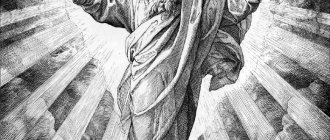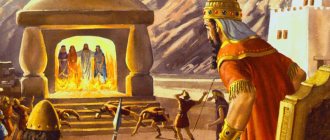- Reports and messages
- Miscellaneous
- Bible
There are many different religions in the world.
The most common of them: Christianity, Islam, Buddhism, Confucianism. The Bible is the main book of all Christians. She is amazing and incredible by definition. The Bible brings people and God closer, teaches patience, understanding and faith. Now the Bible is one of the most popular books in the world. It is published and republished constantly. Many people turn to sacred stories and sayings of prophets and apostles every day. And this is not surprising! The power of the Bible has long been known. The Bible appeared a long time ago. The exact date of its creation is very difficult to name. It was written and assembled gradually. Like life itself. The Holy Book of Christians is divided into two large parts. These are the Old Testament and the New Testament. The Old Testament contains stories about the world before the birth of Jesus Christ. In it you can read about the creation of the world, about Adam and Eve and their expulsion from the Garden of Eden. It also tells about the life of the prophets and the appearance of the Ten Commandments. Here you can also learn the interesting history of the construction of the ark by Noah. About how complex this matter was, how they collected pairs of all living creatures on the big planet and then, when the great flood began, which brought the death of all living things, the inhabitants of the ark were saved.
The New Testament will tell the story of the birth of the Savior - Jesus Christ, the son of God. This moment of the Bible is familiar to all Christians. Every year at Christmas this chapter is heard by all Christians. Few people do not know how little Jesus was born in a stable, and the wise men came to bow to him and brought gifts to the baby, having learned the good news by the bright light of the stars. The Bible also tells about the death of Christ and his miraculous resurrection. The Son of God was executed for loving his neighbors. For the sake of saving people. The holiday of Great Easter was established precisely in honor of the resurrection of Jesus. After the death of the Savior, his twelve disciples - the apostles - continued to preach the word of their teacher. The Bible also contains stories about their difficult lives, travels and sufferings.
A person himself chooses whether or not to read the Bible. But there is definitely no bad meaning in it. The Holy Book of Christians teaches kindness, understanding, patience, and faith. Instills love and respect for elders and parents. Gives new knowledge about the world. Teaches not to be angry, not to betray, not to deceive under any circumstances. The Bible is a good and bright book. They will always quote her, follow her precepts and advice.
There are all kinds of Bible editions in the world. In many languages. They also publish the Bible for children. With interesting pictures and clear stories. Such a book will be viewed with interest by very young children, and read by older children and schoolchildren. Each person will find something of their own in the holy book, something important and valuable. May the Bible never lose its place in the life of modern man. Maybe the world will be kinder thanks to her!
Report No. 2
The Bible is the oldest book and it is sacred in the Christian religion. They wrote it a couple of thousand years ago. It tells about the creation of the world, the Garden of Eden and the first people on Earth - Adam and Eve, and much more.
The Bible is divided into the Old Testament and the New Testament. The Old Testament describes the history of the life and ordeals of the Jewish people. This part of the Bible is also a holy book for the Jewish religion. It contains instructive stories that showed the cruelty and truthfulness of the life of the entire Jewish people. Each chapter is a separate story that reflects both fictional and true historical facts.
The Bible spells out the moral laws and beliefs by which humanity needs to exist. The Ten Commandments are set out in the Old Testament: do not kill, do not steal, do not commit adultery, respect your father and mother. The New Testament also contains many important life laws and instructive stories that became the basis for the Christian religion.
The New Testament describes the story of the birth and life of Jesus Christ, the Son of God. He taught people to do good, raised the dead, and cured the sick. Ordinary people followed him with admiration and greeted him with respect in their own homes. He had many disciples who carried his teachings to the people. But the priests and rulers saw in Jesus a danger to religion and power. They were afraid that ordinary people would obey the Son of God and follow him.
Jesus' disciple Judas sold his own mentor to his enemies for 13 pieces of silver. Jesus was tried and then crucified on Mount Golgotha. But the Son of God rose again and appeared before his followers, and thereby proved that his teaching was fair and correct.
The Bible is a very fascinating book from which you can get a lot of meaningful and useful information. Many authors use episodes from the Bible to create their works: Pushkin A.S., Bulgakov M.A. and other Russian and foreign authors.
Sensational finds?
Books that set out a different version of biblical history and preached a different faith existed for a long time, and no one made a secret of it. But the Church consistently declared them false or at least dubious and did not include them in the Bible. In addition to the apocrypha, which seem to be “on the edge” of the Holy Scriptures and are completely consistent with it (like the same epistles of Clement of Rome or Ignatius of Antioch, younger contemporaries of the apostles), from the first centuries of Christianity there were “alternative sacred histories”, often contradicting not only the Bible, but also to each other. So Dan Brown (author of the acclaimed “The Da Vinci Code” - editor's note) is far from the first. The canonical Gospels, for example, say almost nothing about the childhood of Jesus - only Luke tells about one episode when his parents lost Him in Jerusalem and then found Him in the Temple. But isn’t it really interesting what happened to Him from birth until the moment when He went out to preach? This is how the “Gospel of Childhood” arose, attributed to the Apostle Thomas. Here are excerpts from it: “After that, he walked through the settlement again, and the boy ran up and pushed him on the shoulder. Jesus got angry and said to him: you will not go anywhere further, and the child immediately fell and died... The teacher wrote the alphabet and asked about it for a long time. But he didn't give an answer. And Jesus said to the teacher: if you are a true teacher and know the letters well, tell me what alpha is, and I will tell you what beta is. And the teacher got angry and hit him on the head. And the boy felt pain and cursed him, and he fell to the ground lifeless. And the boy returned to Joseph's house. And Joseph was upset and said to his mother: “Do not let Him out the door, for everyone who provokes His anger dies.”
Does such a “Jesus” look like the One who convinced and did not punish, healed and resurrected, and did not kill, suffered beatings, and did not defeat his enemies? Rather, here we have a not-too-kind sorcerer who does not tolerate the slightest objection. It is not surprising that the Church did not recognize such a Christ and rejected the book as unreliable.
There were many such texts in ancient times, and they continue to be found or composed today (the same Dan Brown). Moreover, it often turns out that a new work repeats old ideas - for example, today's Theosophists often adopt ancient treatises of the Gnostics. These books may well have been popular in their time, but, unlike the Bible or the Koran, they did not become the Holy Scriptures of any viable community. Even after occupying people's minds for a while, they inevitably faded into oblivion. Of course, the canonical Gospels do not contain all the sayings and details of the life of Jesus. Even the Acts of the Apostles (Acts 20:35 ) quote one saying not found in the Gospels: “It is more blessed to give than to receive.” Surely some apocryphal books also contain some completely reliable details. But if these books as a whole do not reflect the image of Christ that is familiar to the Church, then it is difficult to trust them in particulars.
What can we do, people are too easily tempted to use the Good News for momentary propaganda purposes. But the Gospel is alive and active, despite all these attempts, and will always remain so, because it is the true Word of God.
Boblia report-message
The Bible is a Greek word. Translated it means “books”. For Christians, the Bible is the most important and sacred book. She is known and read all over the world. The Bible has become part of the spiritual culture of many peoples of the world.
This sacred book was written over almost one and a half thousand years - from the twelfth century BC to the second century AD. This was a process of selection and editing of religious texts. First, Judaism and then Christianity recognized the texts as divinely inspired, that is, inspired to people by God through Revelation. It was written by hundreds of famous and unknown authors, editors, scribes, translators to whom God revealed his word.
This holy book consists of two parts - the Old Testament and the New Testament. The word “covenant” means a contract, a union of God with the chosen people and all mankind. Accordingly, the part that talks about the union of God with the Jewish people is called the Old Testament (Jews - Tanakh). The New Testament speaks of God's union with all mankind.
The Old Testament, which consists of the Jewish scriptures, was formed in pre-Christian times - from the middle of the first millennium BC to the last decades of the first century AD. It consists of the ancient sacred writings of the Jews. Their correction and editing by Jewish scribes continued until the end of the tenth century AD. The Old Testament is written in Hebrew. There are fragments in Aramaic, which is its dialect.
The Old Testament is also called the Law of Hard Truth. This part of the Bible talks about the creation of the world, about the life of the first people - Adam and Eve. It tells how the history of mankind began, how the first people were expelled from paradise, why the global flood happened. We are talking about the beliefs of the Jewish people, talking about the Messiah, whom everyone was really waiting for
The Bible teaches that God is the source of being, goodness and harmony. The ancient Jews imagined God as one in three persons: Elogium (creative power), Adonai (possessor of the world), Jehovah (person).
The New Testament, which is considered the Law of Divine love and grace, was written by Christians in ancient Greek. It brings together 27 books. They are sacred and recognized by all Christian denominations. The four Gospels: Matthew, Mark, Luke and John speak about the immaculate conception of the Virgin Mary, tell about the earthly life of Jesus Christ, His crucifixion on the cross and resurrection.
The New Testament also consists of the books of Acts and the Epistles of the Apostles, the Revelation of John the Theologian, or the Apocalypse. They describe the heavenly life of Jesus Christ and tell how Christianity spread. These books interpret the essence of the Christian faith, talking about the Last Judgment and the end of the world.
Christian theology, based on the content and orientation of the books of the New Testament, divides them into legal (Gospel), historical (Acts), educational (Epistle) and prophetic (Apocalypse).
The works of the Bible are different in content. But they testify to different ways of understanding the world, teach understanding of reality, and form the foundations of a worldview. We are observing attempts to look into the future of humanity. In the Bible, reality and myths are closely intertwined. Scientists have come to the conclusion that the biblical stories are built on a real basis, the legends are supported by real history. And although many plots, at first glance, are contradictory, they are united by a single powerful spiritual content. This is why the Bible is called the Book of Books.
The Bible has been translated into many languages of the world. Almost ninety percent of the world's population reads it in their native language. In Kievan Rus, the Bible was translated into Old Church Slavonic in the ninth century by the Thessalonica brothers Cyril and Methodius.
4, 5, 8 grade
without an author - How the Bible came to be
1 …
Without author
How the Bible came to be...
Cover photo:
The Israel Museum in Jerusalem also houses this well-preserved scroll of the book of the prophet Isaiah. It was found along with many other scrolls in the caves of Qumran. These manuscripts from the Dead Sea area are today known as the Qumran scrolls.
Preface
The Bible is the Word of God, the revelation of God to us people. It shows in a unique way, unvarnished and yet with divine mercy, who God is, what man looks like (morally) in the eyes of God, and how he can regain fellowship with the Creator.
The Bible authoritatively reveals the causes of personal, social and religious problems of mankind.
Yet this Word of God is often attacked, humiliated, ridiculed, or simply ignored.
How could it happen that the Bible withstood all the attacks of critics, while remaining to this day the most widespread and best-selling book in the world?
Is it because this Book is “spirit and life”? God's power is revealed in it, moreover, it is given to us by the eternal Spirit of God, it is His inspired Word, the breath of God. And in the future this Book will be revealed to every serious reader as a source of life, a masterpiece of literature and morality. The Lord Jesus says: “Heaven and earth will pass away, but My words will not pass away.”
In 1976, a Dutch television studio developed a plan to produce a major biblical television series to be shown on state television. The TV programs were called “The Open Bible.” The main purpose of the program was to provide open-minded viewers with answers to their many questions regarding theology, biblical archaeology, natural history, history and literature.
Doctor of Natural Sciences, Doctor of Philosophy V.I. Auvenel prepared the manuscript of the text of the television program, which was then sent for analysis to representatives of various fields of science. Their notes and comments were also used in the television program and in this book.
We express our heartfelt gratitude to all the staff who participated in the writing of this book, especially Mr. William Y.I. Glashauer and editor-in-chief of the television series “The Open Bible.”
Our desire and prayer to the Lord is that HE may use this book to richly bless the readers. We are grateful to HIM for the opportunity to re-publish this book and would be very glad if it could encourage people seeking answers to the difficult questions of life to read the Book of Books, so that they could study it and accept its wonderful teaching by faith.
In James 1:23 The Word of God is compared to a mirror. The book lying in front of you tells about the wonderful properties and meaning of this mirror, but after reading it, you will not yet see your reflection. It is useful to know the structure, meaning and functions of a mirror, but it is much more useful to use it, and best of all daily.
It is very good and beneficial to expand your knowledge of the origins, transmission from generation to generation, inspiration and authority of the Bible, but it is much better to study the Word of God yourself and let yourself be illuminated by the radiance of the great, omnipotent and loving God, on whose mercy our every step depends.
“But where is wisdom found? and where is the place of reason? Man does not know its value, and it is not found in the land of the living. The Abyss says: “It is not in me”; and the sea says: “not with me.” It is not given for gold, and it is not purchased for the weight of silver. She is not valued with the gold of Ophir, nor with precious onyx, nor with sapphire... God knows her way, and He knows her place. Then He saw her and revealed her; prepared it, and tested it again” (Job 28, 12-16.23.27).
Publishers
1. The Bible is an amazing book!
Since the invention of printing, the Bible has often been the first book printed in a printing house. The so-called Delft Bible (1477) is a great example of this.
We are about to begin a long journey, an excursion through the Bible and its historical background. We want to open the Bible and let it speak first. This can have a stunning effect: after all, the Bible is a big book, or more precisely, a collection of books. It is a whole library of no less than sixty-six books: historical reports, biographies, collections of poems, prophecies, letters, stories, etc. It is no small thing to try to open the Bible with the serious intention of becoming familiar with its contents. The Bible is a very old book, some parts of it are about 3,500 years old or more. This is a book that came to us from completely different times, a different culture, and we will definitely have to take this into account.
One thing must be said right away: since so many people today view the Bible in a negatively critical way, we must seriously consider these common prejudices in order to understand
their meaning. These two points—the historical conditions that form the general background of the Bible, and the critical questions about the Bible—we will have to consider in detail first. Already at this point, the Bible will open to us, because it itself can tell about its origin and about the criticism brought down on it.
Thus, the first part of our work covers the questions of the origin of the Bible: how did it come about? How did it reach us? What confidence do we have in the accuracy of the biblical texts we use today? At the same time, a solid piece of “biblical criticism” is already being analyzed, because in recent centuries theories have emerged that present the question of the origin of the Bible in a completely different way from how it was understood before. The second part will be more devoted to the issue of trust in the Bible - mainly to the content, to a lesser extent - to the problem of compliance of its today's text with the original. Since the advent of modern natural science, modern views of human history, and archeology, the historical and scientific reliability of the Bible has often been questioned. Others, on the contrary, argue that if we distinguish between scientific facts and their interpretation and philosophical theories, and do not attribute to the Bible any information not contained in it, then the Bible can withstand all attacks launched against it under the banner of science. This, of course, would be very remarkable for such an ancient book, so we will have to thoroughly examine this statement in the future.
What is this all for?
One can, of course, ask the question: why make so much fuss over one book? Are there really no more interesting books in the world? There are great ancient religious works that play as important a role in other religions as the Bible does in Christianity! Yes, this is true, but we believe that the Bible is fundamentally different from all other books in the world. We confidently predict: The Bible is completely unique in human history. This is, of course, a strong statement that needs strong evidence. But with this we want to immediately explain why we will talk specifically about the Bible, and we will try to prove our statement in the process of presenting the material.
In many ways, it's not difficult at all. Indeed, there are a lot of objective arguments that can explain to every sane person that the Bible is a completely unique book. To do this, as we will now show, you do not need to be a Christian, or even a religious person. But we must immediately say that such a conclusion will have very serious consequences for every person: if the Bible is completely unique among the millions of books existing in the world, no one has the right to simply pass by it. If we were able to prove the uniqueness and inimitability of the Bible, this, of course, would not mean that it is true and trustworthy, that it is the Word of God. But if there is a book or books on earth that claim to be the Word of God, then we have no right to pass by “this book,” which is different from all world literature and has no equal among it. This is what one associate professor said to a student seeking the Truth: “If you are an intelligent person, then you will read the Book that has attracted more attention than all the others - if you are really looking for the Truth!” Consider, for example, the conclusion of one linguist (M. Montiero-Williams, professor of Sanskrit, an ancient Indian language), made after 42 years of studying Eastern philosophies: “You can stack the books on Eastern philosophy, if you like, on the left edge of your writing table, but place the Bible on the right - separately, leaving a lot of free space between them. Because... there is a gulf between it and between the so-called sacred books of the peoples of the East, a gulf that hopelessly separates the Bible and other books for all times... This is a real gulf that neither science nor religious thinking can cross.” The Bible is so unique! Lying on his deathbed, Sir Walter Scott asked his son-in-law to bring him a “book” and read from it aloud. When he asked what book he was talking about, the dying man replied: “There is only one book worthy of being called simply “Book”, and that is the Bible.” Do you want to participate in our search, rich in interesting discoveries, for evidence of the complete uniqueness of the Bible?
1 …
Popular message topics
- Hornbeam tree
Hornbeam is a deciduous tree from the birch family. The tree's height can reach 30-40 meters, its lifespan can be up to 250 years, and its diameter can be about 2 meters. There are about 40 varieties of this tree, - Climatic zones of the Earth
A climate zone is an area of the planet where the climate is identical or is kept within certain specific standards. Climatic zones are located at different latitudes of the planet, and the climate at each depends on: - Relief wood carving Wood carving
has been considered a traditional craft of many peoples for a very long time. And one of its types is relief carving. Accordingly, it received its name from the word - relief.






